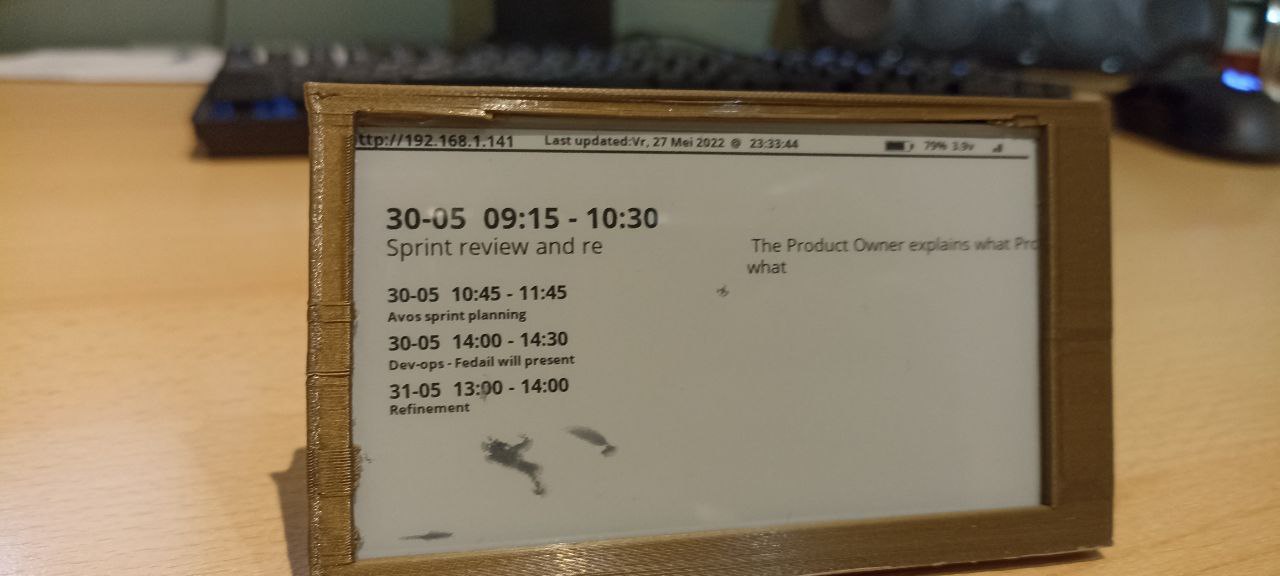LilyGo-EPD-4-7
The LilyGO is an 4.7" e-paper screen. For this project the ESP32 will be located infront of a meetingroom.
My screen has some black shades, I broke thoses pixels
Google scrips
To actually create google scripts go to the folder google_scrips/ and change the agenda names if needed.
Publish the scrips and make sure both of them are selected:
- Execture as user: yourself
- Who has access: everyone
Each script will have its own implementation ID, add them to the own_credentials, or update.
If the get_web_app_token does not exist in the the own_credentials.h file add the token for: String get_web_app_token = "<tImplementatie-ID-token->"; and the line itself.
Compiling and flashing
Edit owm_credentials.h and enter OWM API key as well as the location for which you want to display the weather data
You need Platformio to compile (on VScode)
C:\Users.platformio\packages\framework-
#define CONFIG_MBEDTLS_SSL_MAX_CONTENT_LEN 16384 to --> #define CONFIG_MBEDTLS_SSL_MAX_CONTENT_LEN 32768
Microsoft Office 365 calendar -> Google calendar
Overview
One-way sync from a Microsoft Office 365 Outlook calendar to a Google calendar, handling new, updated, and deleted events.
The script connects to the Microsoft API using the O365 package and connects to the Google API using its Python client. Familiarize yourself with their documentation as you may need to enable APIs or create credentials per their instructions before you begin. See also the Google Calendar API reference.
Setup
- Create
config.py(you can adaptconfig_sample.py) to hold your personal configuration details, include your Microsoftclient_idandclient_secretand your Google calendar ID.- Create a new Google calendar just for this application, or else your existing events will be deleted!
- Create Google credentials for this application (see overview section above) and save as
credentials/google_credentials.json. - Get the Microsoft
client_idandclient_secretby following the O365 instructions on how to authenticate on behalf of a user.
- Run
pip install --upgrade -r requirements.txtto install the required Python dependencies. - In the credentials folder, run
python quickstart.pyto create a Google API access token. - Microsoft API access token is created interactively via URL on first run, then permanently stored. It expires in 90 days if you don't run the script within that time.
- On your server, set up a cron job to run
outlook_to_google.py(using run.sh) every 15 minutes (or however often you need). - The script will check Microsoft for calendar events and compare them to the calendar events it saved (in events_ts.json) during the previous run.
extra docs
** The script will delete all events on this Google calendar and then add some Microsoft calendar events to the Google calendar.**
STEP 1 - Google credentials for OAuth 2.0:
-> Create a project in tthe google cloud platform, don't know if you really really need one but google sugest it.
-> to go the API'S & Services -> Credentials
-> Created an OAuth client ID, first time user? then register
-> Then create a OAuth client id:
1) web application
2) name it to something usefull
3) Create, BUT download the JSON file and place it under creadentials folder with the name google_credentials.json
-> Run the python quickstart.py in the credentials/ folder to create a Google API access token.
STEP 2 - Outlook credentials
-> Follow the following link: instructions O365
-> Click on Authenticate on behalf of a user (public):
-> The tutorial tells the following:
* Create a new APP registration on this page
* Name it with a good name: Accounts in any organizational directory (Any Azure AD directory - Multitenant)
* Select for platform web, without link
* Copy the config_sample.py to the new file config.py
* outlook_client_id is the application (client) ID
* outlook_client_tenant is the Directory (tenant) ID
* Create a secret under the Certificated & secrets -> new client secret -> give it some name and when it expires.
* Copy the secret value from above and place in the config under outlook_client_secret.
STEP 3 - Combine le stuff
-> change in the config the google_calendar_id to your calendar id (settings button when you hover over the agenda in google agenda, settings-and-share-something, then Agenda-ID is your agendaa)
-> TODO Finish this writing..
redirect url opgezet en onder clients een token aangemaakt
Put it in a docker contrainer for syncing
Change your timezone in the Dockerfile if needed.
cd outlook_to_google/
# linux use the following if you want to experiment
DOCKER_BUILDKIT=1 docker build . --tag=outlook_gmail_sync:local
# windows use the following if you want to experiment
set DOCKER_BUILDKIT=0
docker build . --tag=outlook_gmail_sync:local
# linux/winhows use the following if you want to experiment
docker build . --tag=outlook_gmail_sync:local
# testing
docker run -it outlook_gmail_sync:local
# prod
docker run -d outlook_gmail_sync:local
